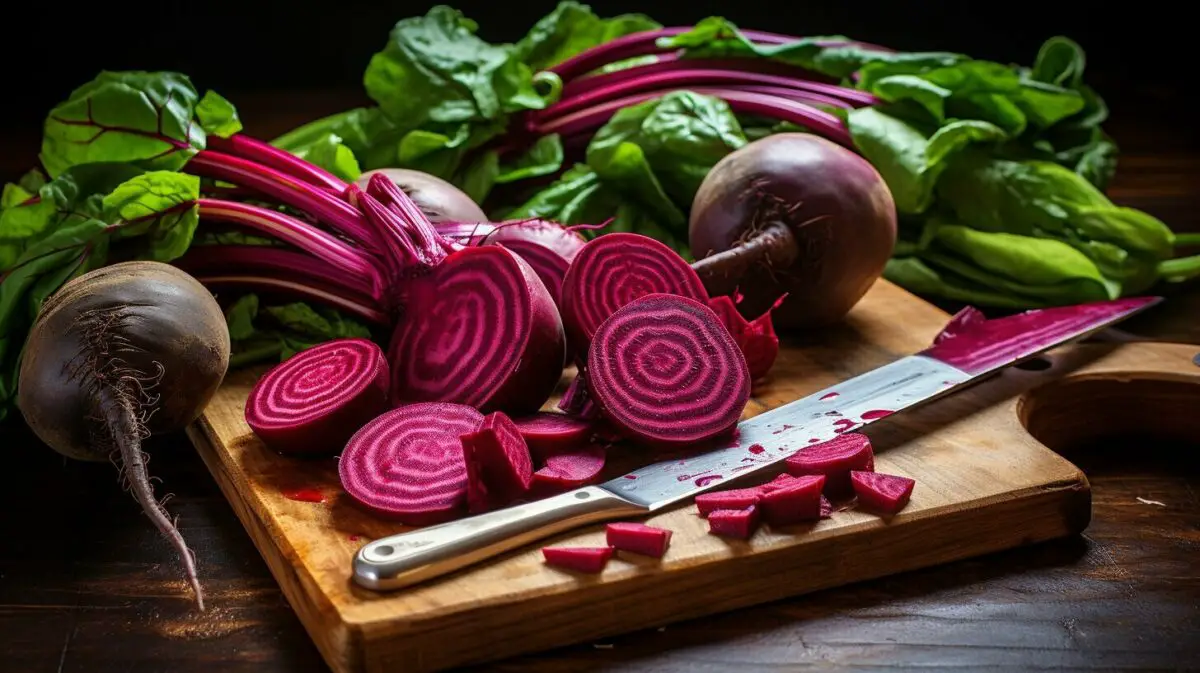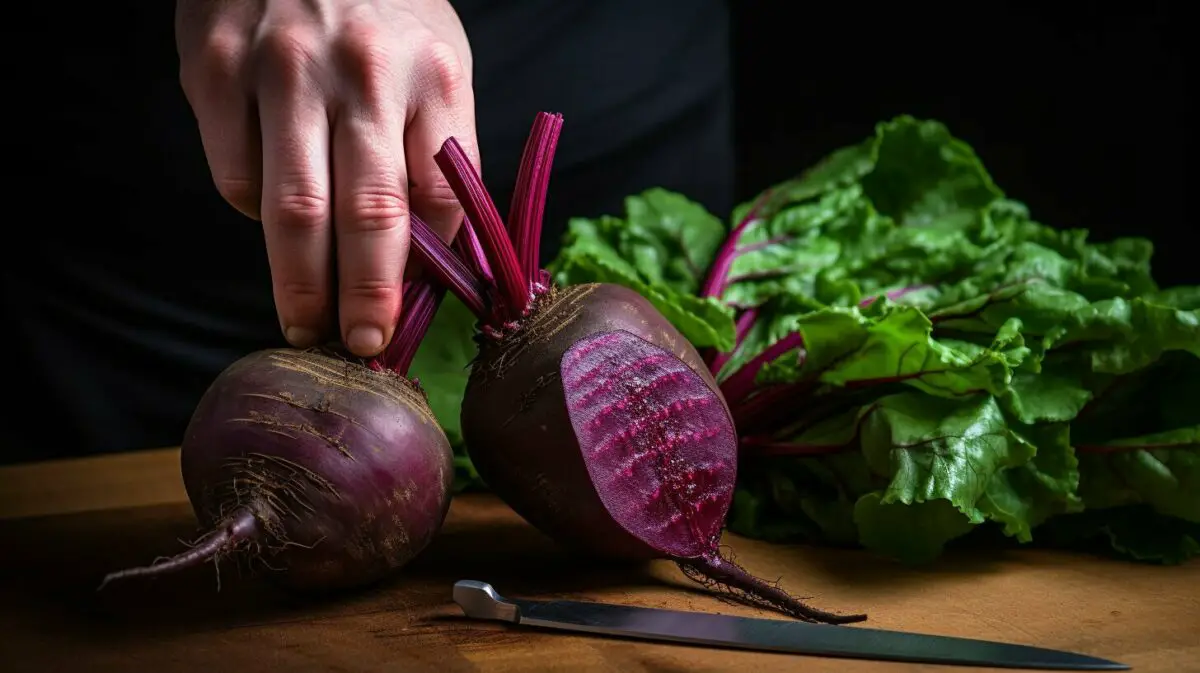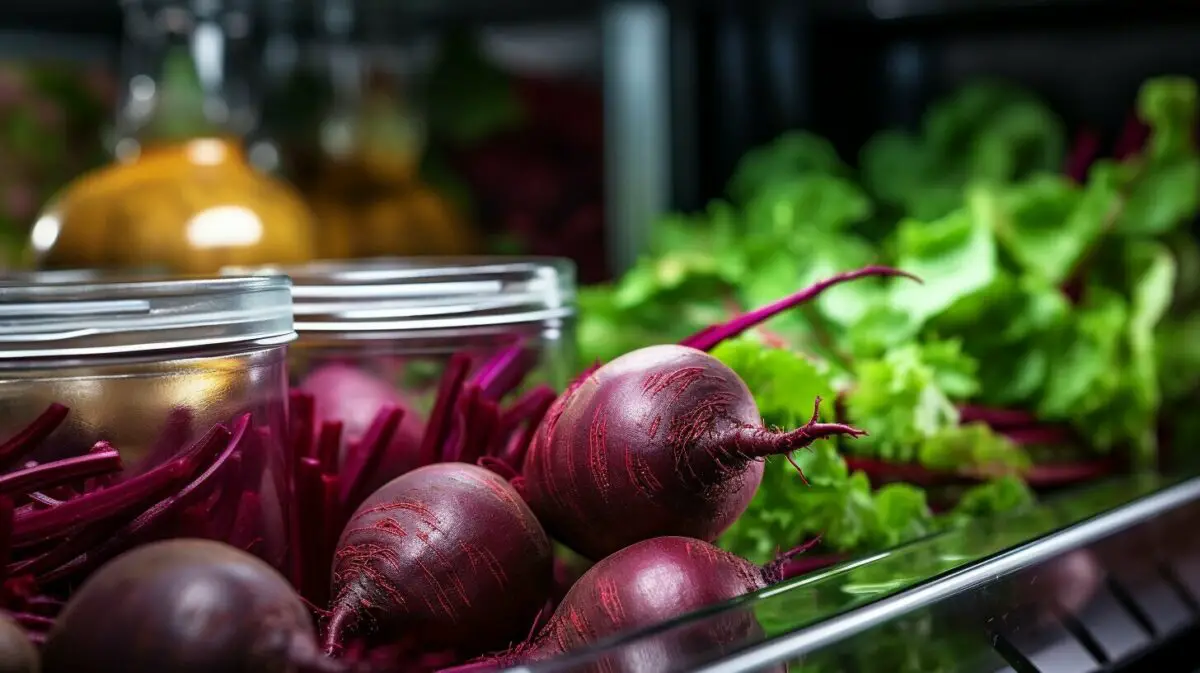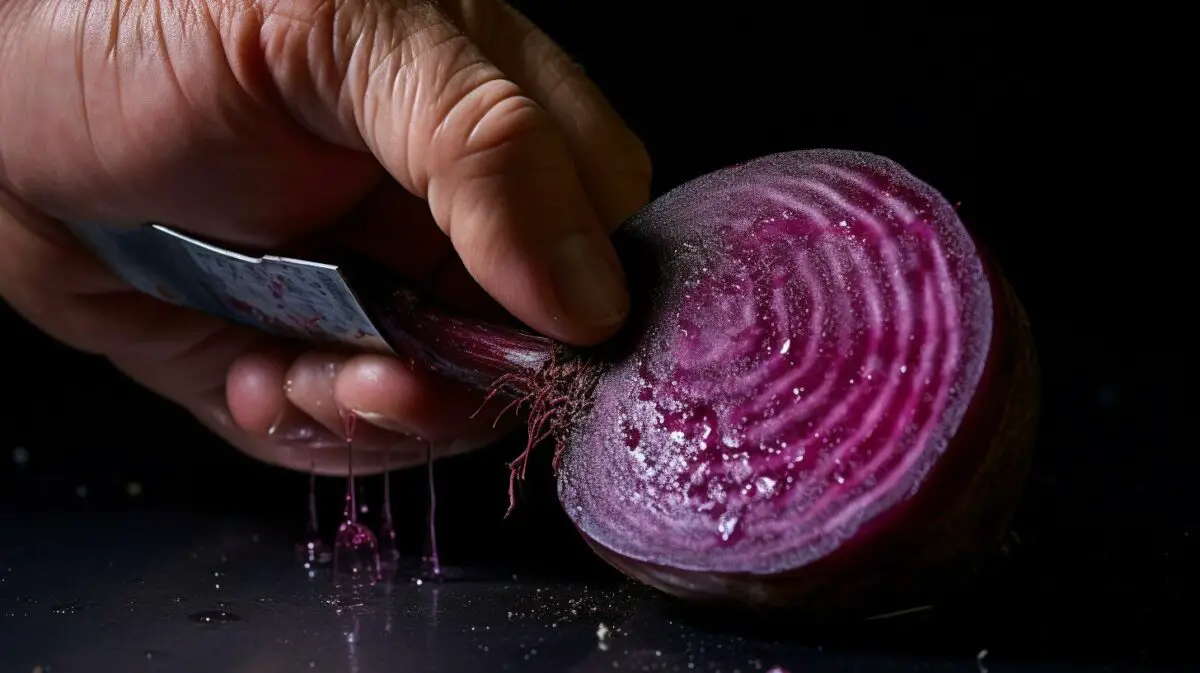How to Cut Beets
Cutting beets can seem intimidating, but with the right techniques, you can easily unlock the full flavor of this nutritious vegetable.
To cut beets, start by rinsing and scrubbing the beets under water. Then, trim off the stem and root ends with a sharp knife. If desired, peel the beets using a vegetable peeler or paring knife.
There are three common cutting techniques for beets: circles, half moons, and cubes. For circles, lay the beet on its side and slice it into circles of desired thickness. For half moons, cut the beet in half and then slice each half into half-moon shapes. For cubes, cut the beet into thick slices, lay each slice flat, and cut them vertically and horizontally to create cubes.
Use a sharp knife and a firm grip on the beet when cutting. To prevent staining, wear gloves or wash hands with lemon juice after handling beets.
Store cut beets in the fridge for up to 2-3 weeks or freeze them after blanching for up to 6 months. The choice to peel beets before cooking them is optional, and peeled beets can be blended or cooked. When cooking with beets, dice them for roasting or adding to salads, soups, or curries. Whole beets can also be roasted or used in dishes like pasta sauce or salads.
How to Cut Beets – Key Takeaways:
- Start by rinsing and scrubbing the beets under water before cutting.
- Trim off the stem and root ends with a sharp knife.
- Consider peeling the beets with a vegetable peeler or paring knife.
- Cut beets into circles, half moons, or cubes.
- Use a sharp knife and maintain a firm grip for safe and precise cuts.
The Basics: Preparing Beets for Cutting
Before you start cutting beets, it’s essential to properly prepare them by rinsing, scrubbing, and trimming off the ends. This ensures that your beets are clean and ready to be sliced, diced, or chopped according to your recipe’s requirements.
To begin, rinse the beets under cool running water to remove any dirt or debris. Use your hands or a vegetable brush to gently scrub the outer surface of the beets, removing any stubborn dirt or rough patches. This step is crucial to ensure that no unwanted particles are left on the beets, giving you a clean and safe surface to work with.
Next, trim off the stem and root ends of the beets using a sharp knife. This not only ensures that your beets have a neat appearance but also makes it easier to handle and cut them into the desired shapes. Make sure to trim just enough to remove the tough or woody parts, without wasting any of the beet’s flesh.
If you prefer to peel your beets, you can use a vegetable peeler or paring knife to remove the outer skin. This step is optional and depends on personal preference and the specific recipe you’re following. Peeling can help achieve a smoother texture in some dishes or enhance the visual appeal of the final presentation.
Properly preparing your beets before cutting them is crucial for several reasons. Firstly, it ensures that any dirt or impurities are removed, reducing the risk of contamination. This is especially important when consuming beets raw or using them in salads.
Secondly, trimming off the stem and root ends creates a uniform shape, making it easier to handle and cut the beets. It also removes any tough or woody parts that may affect the taste or texture of the final dish.
Lastly, peeling the beets can enhance the aesthetic appeal of your dishes. While the skin of beets is edible and contains valuable nutrients, peeled beets offer a smoother and more refined appearance. This can be particularly desirable in dishes where presentation matters, such as beet carpaccio or beet tartare.
By following these basic steps of rinsing, scrubbing, trimming, and peeling (if desired), you’ll be well-prepared to tackle the next stage of cutting your beets according to your recipe’s instructions.
| Steps for Preparing Beets for Cutting: |
|---|
| Rinse the beets under cool running water. |
| Gently scrub the beets to remove any dirt or rough patches. |
| Trim off the stem and root ends using a sharp knife. |
| Optional: Peel the beets using a vegetable peeler or paring knife. |
Tools for Cutting Beets
To achieve clean and precise cuts, it’s crucial to have the right tools on hand, including a sharp chef’s knife, a paring knife for delicate tasks, a serrated knife for tougher beets, and a sturdy cutting board. Let’s take a closer look at each of these essential tools:
- Chef’s Knife: This versatile knife with a broad blade and sharp, tapered edge is ideal for slicing, dicing, and chopping beets. Its length and weight enable smooth and efficient cutting, making it a must-have for any vegetable preparation.
- Paring Knife: For more delicate tasks like peeling beets or making intricate cuts, a paring knife is the perfect choice. Its small size and narrow blade provide better control and precision, allowing you to handle beets with ease.
- Serrated Knife: When dealing with tough-skinned beets, a serrated knife comes to the rescue. The serrated edge allows you to easily cut through the beet’s outer layer without crushing or squishing the flesh inside.
- Cutting Board: To ensure stability and avoid accidents, a sturdy cutting board is essential. Opt for a non-slip, non-absorbent material like wood or plastic. A cutting board with a groove around the edges will help catch any beet juice, keeping your workspace clean.
Remember, using sharp knives and a stable cutting surface not only improves your cutting technique but also ensures safety in the kitchen. Now that we’ve covered the tools, let’s move on to the various techniques for cutting beets.
Table: Essential Tools for Cutting Beets
| Tool | Description |
|---|---|
| Chef’s Knife | A versatile knife with a broad blade and sharp, tapered edge for slicing, dicing, and chopping beets. |
| Paring Knife | A small, narrow-bladed knife perfect for delicate tasks like peeling and making intricate cuts on beets. |
| Serrated Knife | A knife with a serrated edge, ideal for cutting through tough beet skins without damaging the flesh inside. |
| Cutting Board | A stable, non-slip surface for safely and effectively cutting beets. Choose a non-absorbent material like wood or plastic. |

Depending on your recipe and personal preference, you can cut beets into circles, half moons, or cubes to achieve different shapes and textures. Here are step-by-step instructions for each technique:
Circles:
- Rinse and scrub the beets under water to remove any dirt or debris.
- Trim off the stem and root ends with a sharp knife.
- Using a sharp knife, lay the beet on its side and slice it into circles of your desired thickness. Make sure to keep your fingers away from the blade and maintain a firm grip on the beet.
Half Moons:
- Follow the same initial steps of rinsing, scrubbing, and trimming the beets.
- Cut the beet in half lengthwise.
- Place each half flat side down and slice them into half-moon shapes.
Cubes:
- Start with the same preparation steps of rinsing, scrubbing, and trimming the beets.
- Cut the beet into thick slices.
- Lay each slice flat and cut them vertically and horizontally to create cubes.
Remember to always use a sharp knife for clean cuts and have a firm grip on the beet. It’s also a good idea to wear gloves or wash your hands with lemon juice after handling beets to prevent staining.
Now that you know the different cutting techniques, you can experiment with these shapes in your favorite beet recipes. The diverse textures and sizes of beet cuts can add visual appeal and variety to your dishes. Whether you’re roasting, sautéing, or adding beets to salads or soups, these cutting techniques will help you achieve the desired results.

| Technique | Advantages | Best Used for |
|---|---|---|
| Circles | Uniform shape and size | Salads, pickling, cooking beets as a side dish |
| Half Moons | Elegant presentation | Roasting, sautéing, garnishing |
| Cubes | Versatile and easy to measure | Soups, stews, stir-fries |
Slicing Beets with a Knife
Slicing beets with a knife requires a steady hand, a sharp blade, and a proper grip to achieve consistent and professional-looking slices. Whether you’re preparing beets for a salad, a side dish, or a colorful garnish, mastering the art of slicing them can elevate your culinary creations. Follow these steps to slice beets with precision and confidence:
Step 1: Prepare the Beet
Start by rinsing and scrubbing the beet under running water to remove any dirt or debris. Trim off the stem and root ends with a sharp knife, creating a flat surface for stability during slicing. If desired, peel the beet using a vegetable peeler or paring knife, ensuring a smoother texture for your slices.
Step 2: Choose Your Cutting Technique
There are various ways to cut beets, depending on your recipe and preference. The three common techniques are circles, half moons, and cubes. For circles, lay the beet on its side and slice it into rounds of your desired thickness. For half moons, cut the beet in half and then slice each half into half-moon shapes. For cubes, cut the beet into thick slices, lay each slice flat, and cut them vertically and horizontally to create even cubes.

Step 3: Master the Technique
When slicing beets, always use a sharp knife to ensure clean and effortless cuts. Hold the beet with a firm grip to maintain control and minimize the risk of accidents. Apply steady pressure while sliding the knife through the beet, using a sawing motion if necessary. Take your time and stay focused to achieve beautifully sliced beets that will enhance the visual appeal of your dishes.
Now that you know the secrets to slicing beets with a knife, you can confidently incorporate this vibrant vegetable into your culinary creations. Remember to maintain a steady hand, use a sharp blade, and grip the beet firmly. With practice and precision, you’ll be slicing beets like a pro in no time!
Preventing Staining and Discoloration
Beets have a vibrant color that can easily stain surfaces, so it’s important to take precautions to prevent staining and discoloration. Here are some tips to keep your hands, cutting surfaces, and utensils clean and stain-free.
- Wear gloves: To avoid direct contact with the beet juice, consider wearing disposable gloves when handling beets. This will help protect your hands from stains and make cleanup easier.
- Wash hands with lemon juice: If you prefer not to use gloves, you can wash your hands with lemon juice immediately after handling beets. Lemon juice has natural bleaching properties that can help remove stains and reduce discoloration.
- Protect cutting surfaces: Place a plastic cutting board or a sheet of parchment paper on your cutting surface to create a barrier between the beets and the surface. This will prevent your countertop or cutting board from absorbing the beet juice and getting stained.
- Clean utensils promptly: After cutting beets, wash your knives, peelers, and other utensils right away to minimise staining. Use hot, soapy water and scrub them thoroughly to remove any beet residue.
By following these simple steps, you can enjoy the vibrant colors of beets without worrying about unsightly stains. Remember, prevention is key when it comes to maintaining a clean and stain-free kitchen environment!

“I always wear gloves when working with beets to prevent my hands from turning red. But if I forget, a quick wash with lemon juice does the trick!” – Sarah, Home Cook
| Prevention Tip | Key Point |
|---|---|
| Wear gloves | Protects hands from stains |
| Wash hands with lemon juice | Natural stain remover |
| Protect cutting surfaces | Prevents countertop staining |
| Clean utensils promptly | Minimizes beet residue and stains |
Storing Cut Beets
Once you’ve cut your beets, it’s crucial to store them properly to keep them fresh and ready to use in various recipes. Proper storage will help maintain their flavor, texture, and nutritional value. Here are some tips on how to store cut beets:
- Wrap the cut beets in plastic wrap: To prevent them from drying out and absorbing odors from other foods in the fridge, tightly wrap the cut beets in plastic wrap. Make sure to cover the entire surface of the beets to keep them fresh.
- Place them in an airtight container: After wrapping the cut beets in plastic wrap, transfer them to an airtight container. This will provide an extra layer of protection against moisture and air, helping to extend their shelf life.
- Store in the refrigerator: Keep the container of cut beets in the refrigerator at a temperature between 32°F and 40°F (0°C and 4°C). They can be stored this way for up to 2-3 weeks, depending on their freshness at the time of cutting.

By following these storage tips, you can enjoy the convenience of having cut beets readily available for your cooking needs. Whether you’re adding them to salads, roasting them for a side dish, or incorporating them into various recipes, properly stored cut beets will retain their vibrant color and taste.
Cooking with Cut Beets
Cut beets open up a world of culinary possibilities, allowing you to create delicious dishes like vibrant salads, refreshing smoothies, crispy chips, comforting soups, and more. With their earthy flavor and vibrant color, beets add a unique twist to any recipe. Whether you’re an experienced chef or a beginner in the kitchen, there are countless exciting ways to incorporate cut beets into your cooking repertoire.
If you’re looking for a light and nutritious option, try making a beet salad. Simply dice the cut beets and toss them with fresh greens, goat cheese, walnuts, and a tangy vinaigrette. The combination of sweet beets and savory toppings creates a delightful balance of flavors. For a refreshing pick-me-up, blend cut beets into a vibrant smoothie with your favorite fruits and a splash of coconut water or almond milk. The natural sweetness of the beets pairs perfectly with tropical flavors like mango and pineapple.
If you’re craving something crispy and satisfying, why not make beet chips? Thinly slice the cut beets, toss them with olive oil, salt, and your choice of seasonings, and bake them until they’re crispy and golden. These crunchy snacks are not only delicious but also a healthier alternative to regular potato chips. For a warming and hearty meal, incorporate cut beets into soups or stews. Their vibrant color adds a pop to any bowl, and their natural sweetness enriches the flavors of the dish.
| Delicious Beet Recipes | Recipe Inspiration |
|---|---|
| Beet Hummus | “The beet hummus was a game-changer! The vibrant color and earthy taste took my hummus game to the next level. It’s the perfect dip for veggies or pita chips!” – Sarah |
| Beet Pickles | These homemade beet pickles are a tangy and colorful addition to any sandwich or salad. Plus, they’re super easy to make!” – Mark |
- Beet Greens
- Beet Juice
- Beet Slaw
- Beet Carpaccio
- Beet Noodles
- Beet Fries
- Beet Hash
- Beet Risotto
- Beet Tartare
- Beet Puree

One of the most popular beet-based dishes is beet salad. The combination of tender beets, fresh greens, crunchy nuts, and tangy dressing creates a delightful mix of flavors and textures. You can customize your beet salad with additional ingredients like goat cheese, citrus fruits, or even grilled chicken for a more substantial meal. The possibilities are endless!
So, the next time you have cut beets on hand, get creative in the kitchen and explore the many culinary wonders they have to offer. From vibrant salads to comforting soups, beets will add a colorful twist to your meals and bring a burst of flavor and nutrients to your table.
Other Beet Preparation Techniques
In addition to cutting, there are other techniques you can use to prepare and cook beets, offering different textures and flavors. These techniques include spiralizing, roasting, and boiling. Each method brings out unique characteristics of beets, allowing you to experiment with new recipes and create delightful dishes.
Spiralizing Beets: Spiralizing beets transforms them into beautiful noodle-like strands, perfect for adding a vibrant twist to your salads, stir-fries, or pasta dishes. Simply peel the beets, attach them to a spiralizer, and turn the handle to create beautiful beet spirals.
Roasted Beets: Roasting beets intensifies their natural sweetness and enhances their earthy flavor. To roast beets, preheat your oven to 400°F (200°C). Scrub the beets, wrap them individually in foil, and place them on a baking sheet. Roast for about 45-60 minutes, or until they are tender when pierced with a fork. Once cooled, the skin will easily peel off, revealing the tender, roasted beets ready to be enjoyed in a salad or as a side dish.
Boiled Beets: Boiling beets is a simple and quick method that results in tender, cooked beets. Start by trimming off the stem and root ends, then place the beets in a pot of boiling water. Cook for about 30-40 minutes, or until they are easily pierced with a fork. Once cooked, peeled and sliced boiled beets can be enjoyed in salads, soups, or used as a colorful addition to your favorite dishes.
| Beet Preparation Technique | Description |
|---|---|
| Spiralizing Beets | Transform beets into noodle-like strands for salads and pasta dishes. |
| Roasted Beets | Intensify the sweetness of beets by roasting them in the oven. |
| Boiled Beets | Cook beets in boiling water for a tender and versatile ingredient. |
“Spiralizing beets adds a fun and colorful twist to any dish. The spiralized beet noodles are not only visually appealing but also provide a refreshing crunch and a burst of flavor that complements a variety of ingredients.”
– Chef Emily
So whether you choose to spiralize, roast, or boil your beets, these methods will unlock new culinary possibilities and allow you to enjoy the unique flavors and textures of this nutritious vegetable.

Peeling beets is a personal choice that can affect the texture and appearance of your cooked dishes, so it’s important to consider the benefits and drawbacks.
When it comes to peeling beets, there are a few things to keep in mind. The skin of beets is edible and provides additional nutrients, such as fiber and antioxidants. Leaving the skin on can also enhance the flavor and add a vibrant color to your dishes. However, the skin can sometimes be tough and may not be desirable in certain recipes, such as smoothies or purees. Peeling the beets can result in a softer texture and a smoother consistency.
If you decide to peel your beets, there are a few methods you can use. One option is to use a vegetable peeler, which allows you to easily remove the skin while minimizing waste. Another method is to use a paring knife to carefully trim off the skin. Whichever method you choose, make sure to wash the beets thoroughly before peeling to remove any dirt or debris.
Once the beets are peeled, they can be cooked in a variety of ways. Diced beets are great for roasting or adding to salads, soups, or curries. You can also blend peeled beets to create a creamy puree that can be used as a base for dips or sauces. The choice to peel or not to peel ultimately depends on your personal preference and the specific recipe you are following.

To help you make an informed decision, here are some pros and cons of peeling beets:
| Pros | Cons |
|---|---|
|
|
Ultimately, whether you choose to peel your beets or not, remember that both options can result in delicious and nutritious dishes. It’s all about personal preference and finding the method that works best for you and your cooking style. So go ahead and experiment with both peeled and unpeeled beets to discover the flavors and textures that you enjoy the most!
Reaping the Benefits of Cut Beets
Beets are not only tasty but also packed with essential nutrients and offer a wide range of health benefits when incorporated into your diet. These vibrant root vegetables are a nutritious vegetable choice that can contribute to a well-balanced and wholesome eating plan.
Rich in vitamins and minerals, beets are particularly high in folate, manganese, and potassium. Folate is essential for cell growth and development, while manganese plays a vital role in metabolism and bone health. Potassium, on the other hand, helps maintain healthy blood pressure levels and supports proper nerve and muscle function.
Additionally, beets are a great source of dietary fiber, which aids in digestion and helps promote feelings of fullness. This can be beneficial for weight management and overall gut health. Moreover, beets contain antioxidants that can help fight cellular damage caused by harmful free radicals, potentially reducing the risk of chronic diseases such as heart disease and certain types of cancer.
| Nutrient | Amount per 100g |
|---|---|
| Calories | 43 |
| Carbohydrates | 9.6g |
| Protein | 1.6g |
| Fat | 0.2g |
| Fiber | 2.8g |
| Vitamin C | 4.9mg |
| Folate | 109μg |
| Potassium | 305mg |
Considering the many health benefits and nutritional value of beets, it’s no wonder they have become a popular ingredient in various dishes. From salads and smoothies to roasted vegetables and hearty soups, there are numerous creative ways to incorporate cut beets into your meals. So why not explore the vibrant world of beets and reap the rewards of their amazing health benefits?

“Beets are a nutritious powerhouse that can boost your overall well-being, thanks to their abundance of vitamins, minerals, and antioxidants.”
– Nutritionist Amanda Jones
Additional Health Benefits of Beets:
- Supports healthy brain function and cognition
- May help lower blood pressure
- Aids in detoxification and liver health
- Enhances athletic performance and endurance
- Promotes healthy skin and hair
Incorporating cut beets into your diet can not only add depth and flavor to your meals but also contribute to your overall well-being. So, go ahead and explore the endless possibilities of enjoying this nutritious vegetable in your favorite recipes.
| Recipe | Description |
|---|---|
| Beet and Goat Cheese Salad | Refreshing salad with the perfect balance of sweet beets and tangy goat cheese. |
| Roasted Beet Hummus | A creamy and flavorful twist on traditional hummus, perfect for dipping. |
| Beet Chips | A healthy alternative to potato chips, crispy and satisfying. |
| Beetroot Soup | A comforting and hearty soup, bursting with earthy flavors. |
How to Cut Beets – Conclusion
Mastering the art of cutting beets opens up a world of culinary exploration, allowing you to unleash the full potential of this nutritious vegetable in your everyday cooking. By following a few simple steps, you can transform beets into a versatile ingredient that adds color, flavor, and health benefits to a wide range of dishes.
To start, ensure your beets are clean and trimmed by rinsing, scrubbing, and trimming off the stem and root ends. If desired, you can peel them using a vegetable peeler or paring knife. Once your beets are prepped, there are three common cutting techniques you can utilize: circles, half moons, and cubes. Each style offers its own unique presentation and lends itself to different recipes.
When cutting beets, it’s important to use a sharp knife and maintain a firm grip on the vegetable for clean and precise cuts. To prevent staining, consider wearing gloves or washing your hands with lemon juice after handling beets. Storing cut beets is easy – simply keep them in the fridge for up to 2-3 weeks or freeze them after blanching for up to 6 months.
Whether you choose to peel your beets or leave the skin on is entirely up to you. Peeled beets can be blended into soups or purees, while unpeeled beets can be roasted or used in recipes like pasta sauce or salads. Experimenting with different cooking methods and recipes will allow you to discover the delightful flavors and textures that beets can bring to your meals.
How to Cut Beets – FAQ
Q: How should I rinse and prepare the beets for cutting?
A: Start by rinsing and scrubbing the beets under water. Trim off the stem and root ends with a sharp knife. If desired, peel the beets using a vegetable peeler or paring knife.
Q: What are the different cutting techniques for beets?
A: There are three common cutting techniques for beets: circles, half moons, and cubes.
Q: How do I cut beets into circles?
A: Lay the beet on its side and slice it into circles of desired thickness.
Q: How do I cut beets into half moons?
A: Cut the beet in half and then slice each half into half-moon shapes.
Q: How do I cut beets into cubes?
A: Cut the beet into thick slices, lay each slice flat, and cut them vertically and horizontally to create cubes.
Q: What precautions should I take while cutting beets?
A: Use a sharp knife and have a firm grip on the beet when cutting. To prevent staining, wear gloves or wash hands with lemon juice after handling beets.
Q: How long can I store cut beets?
A: You can store cut beets in the fridge for up to 2-3 weeks or freeze them after blanching for up to 6 months.
Q: Do I need to peel beets before cooking?
A: The choice to peel beets before cooking them is optional. Peeled beets can be blended or cooked.
Q: How should I dice beets for cooking?
A: Dice beets for roasting or adding to salads, soups, or curries.
Q: What can I make with whole beets?
A: Whole beets can be roasted or used in dishes like pasta sauce or salads.
Our Friends:
- https://itsavegworldafterall.com/how-to-cut-beets/
- https://feelgoodfoodie.net/recipe/how-to-cut-beets/
Related Recipes:
 How to Cook Beets? (Perfect Step-By-Step Guide)
How to Cook Beets? (Perfect Step-By-Step Guide)
 How to Cut a Tomato? (Perfect Step-By-Step Guide)
How to Cut a Tomato? (Perfect Step-By-Step Guide)
 How to Cut a Watermelon? (Perfect Step-By-Step Guide)
How to Cut a Watermelon? (Perfect Step-By-Step Guide)
 How to Cut Dragon Fruit? (Perfect Step-By-Step Guide)
How to Cut Dragon Fruit? (Perfect Step-By-Step Guide)
 How to Cut an Orange? (Step-By-Step Guide)
How to Cut an Orange? (Step-By-Step Guide)
 How to Cut Green Onions? (Step-By-Step Guide)
How to Cut Green Onions? (Step-By-Step Guide)
 How to Cut Mushrooms? (Perfect Step-By-Step Guide)
How to Cut Mushrooms? (Perfect Step-By-Step Guide)
 How to Cut Carrots? (Perfect Step-By-Step Guide)
How to Cut Carrots? (Perfect Step-By-Step Guide)








